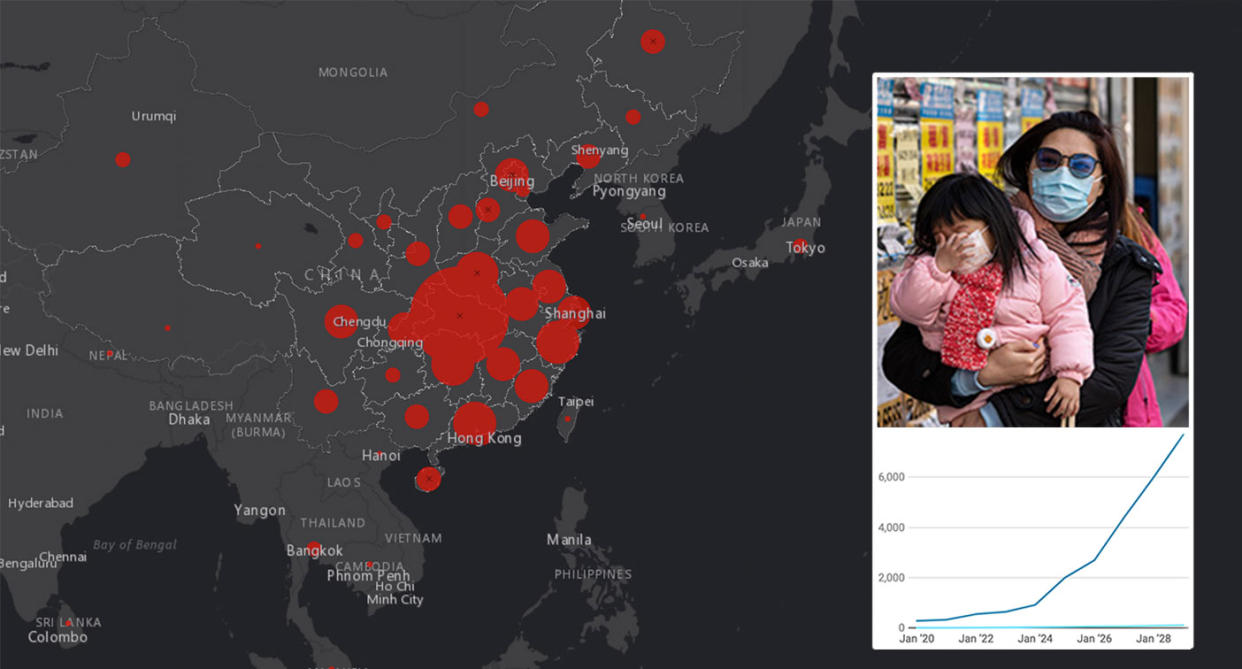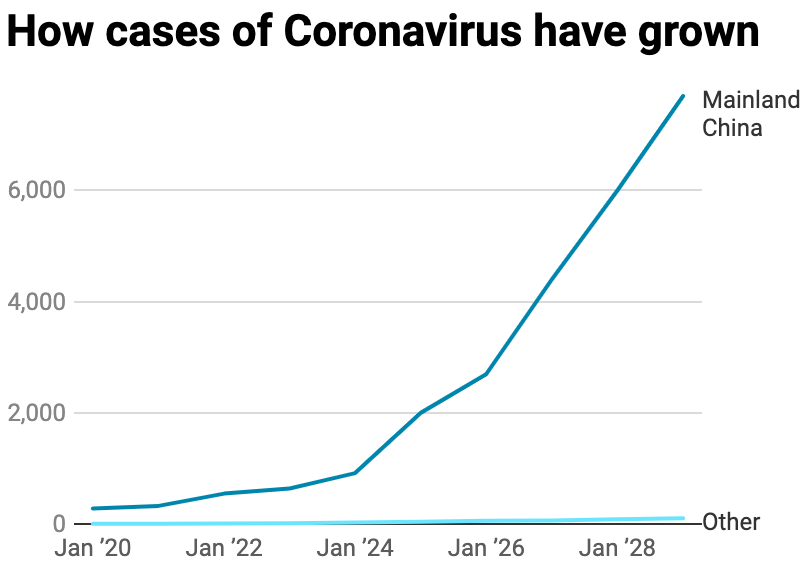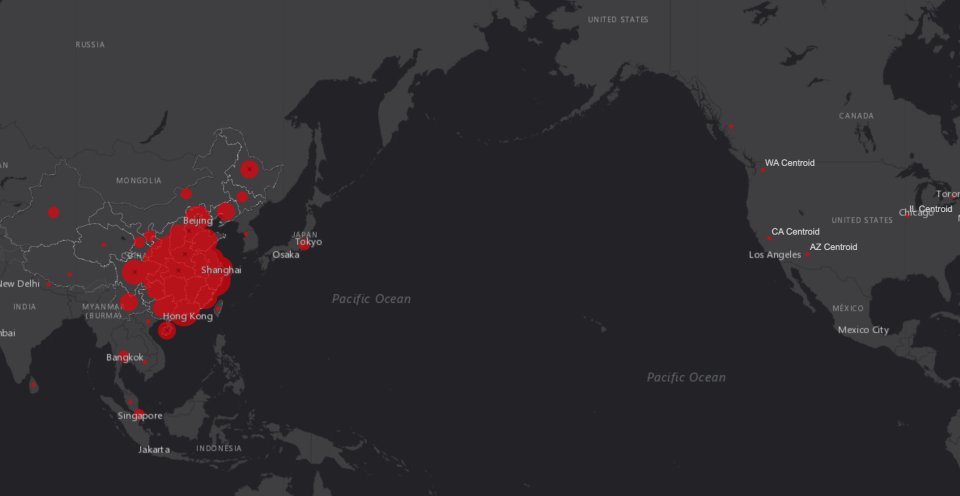The chart that shows the rapid rise in China's coronavirus cases

China’s deadly coronavirus is making headlines all over the world.
Since emerging at the end of last year in the city Wuhan, capital of Hubei province, the previously unknown strain has reached every region in mainland China.
The death toll hit 170 on Thursday, with authorities confirming 7,711 cases in China alone, up from 4,500 on Tuesday.
READ MORE: China's coronavirus is 'spreading quicker than Sars'
The new strain has also crossed national borders, spreading to at least 15 countries, including the US, Canada and France.
Symptoms are typically flu-like, including fever and breathlessness. In the most severe cases, victims succumb to pneumonia.
How has the new coronavirus spread throughout China?
The new strain - 2019-nCoV - is believed to have originated at a seafood and live animal market that “conducted illegal transactions of wild animals”, the BBC reported.
Chinese authorities confirmed last week it can spread from person-to-person, via sneezing, coughing or shaking contaminated hands.

The above graph, put together with data from John Hopkins University, reveals mainland China had 278 confirmed cases on January 20.
Just four days later, this had climbed to 916.
Cases then increased exponentially, reaching more than 7,000 on January 29.
2019-nCoV is being compared to fellow coronavirus severe acute respiratory syndrome (Sars).
This is thought to have infected the first human in the Chinese province Guangdong in November 2002.
Authorities were famously tight-lipped about the outbreak, not informing the WHO until February 11, when 305 cases - and five deaths - had occurred across six districts in Guangdong.
By March 21, suspected and probable cases reached 350 - including 10 deaths - in 13 countries.
On March 31, 1,622 people were infected, of which 58 died, according to Nature.
By the end of the outbreak in 2004, 774 people had died across dozens of countries. No known cases have been reported anywhere in the world since, the NHS reports.
Another coronavirus outbreak was the Middle East respiratory syndrome (Mers).
The first two patients were identified in Saudi Arabia in September 2012, of which one died.
A third incidence was reported on November 4, according to the European Centre for Disease Prevention and Control.
In May, the infection reached France. Forty four cases were reported overall at that time, with 22 deaths.
The 2012 outbreak went onto infect 2,494 people, killing 858, Science Alert reported.

A map by John Hopkins University (above) also highlights exactly how far the new virus has spread around China.
Cases are concentrated in Hubei, with 4,586 patients and 162 deaths.
This is followed by 428 incidences in the province Zhejiang, some 562 miles (906km) away.
Guangdong, 637 miles (1,026km) from Hubei, has 311 confirmed cases.
The fewest are in Tibet, 1,393 miles (2,243km) from the epicentre of the outbreak, with just one confirmed.
How has the new coronavirus spread outside of China?
While incidences are on the rise in the rest of the world, numbers are creeping up far slower.
On January 20, four cases were confirmed in “other locations” outside of mainland China.
This rose to 25 on January 24 and 105 on January 29.
Outside of mainland China, Thailand has the most confirmed cases, with 14.
This is followed by 11 in Japan, and 10 in both Hong Kong and Singapore.
The virus has also reached North America, with five cases in the US and three in Canada.
It has also been brought to Europe, with France, Germany and Finland having five, four and one patients, respectively.
Incidences in Germany, Vietnam and Japan are particularly concerning given that they came about via human-to-human transmission from someone who had been to China.
READ MORE: What are the symptoms of China's coronavirus?
This prompted the World Health Organization’s director-general to call a committee meeting to re-discuss whether to make the outbreak a “global health emergency”.
He decided against it last week, citing “no evidence of human-to-human transmission outside China”.
The coronavirus is spreading internationally despite many countries screening passengers for signs of infection.
Critics argued symptoms can take days to appear, with newly-infected travellers potentially being allowed through.
When it comes to the speed of transmission, scientists from Imperial College London estimated each patient in China infected between 1.5 and 3.5 people up to January 18.
A team from the University of Oxford predicted if a virus-ridden person were to arrive in the UK, there is more than a one-in-three chance they will pass it on.
Based on data collected between January 10 and 21, scientists from the Chinese University of Hong Kong estimate each patient could pass the virus onto between three and five people.

Who is most likely to catch the new coronavirus?
The new coronavirus has the potential to infect anyone.
Doctors from Wuhan Jinyintan Hospital published details on 99 patients who were transferred there between January 1 and 20.
The patients had an average age of 55, with 67 being male.
Almost half (49%) had “a history of exposure to the seafood market” and 51% an underlying illness.
Of these, 40 reported “cardiovascular and cerebrovascular diseases”.
Although unspecified, these may include high blood pressure or a history of stroke.
Twelve patients had diabetes, the data shows.
Other coronaviruses, ranging from the common cold to Middle East respiratory syndrome (Mers), tend to only trigger serious complications in the elderly, young or those with pre-existing medical conditions.
“Young children are most likely to get infected,” according to the Centers for Disease Control and Prevention (CDC).
How does the new coronavirus kill patients?
Fatal pneumonia comes about when a respiratory infection causes the alveoli (air sacs) in the lungs to become inflamed and filled with fluid or pus, according to the American Lung Association.
The lungs then struggle to draw in air, resulting in reduced oxygen in the bloodstream.
“Without treatment the end is inevitable,” said the charity Médecins Sans Frontières.
“Deaths occurs because of asphyxiation.”
The CDC has warned there is no specific treatment for coronaviruses.
If the infection triggers pneumonia, doctors work to combat the complication.
When a virus is to blame – like 2019-nCoV – pneumonia may be treated via “antiviral medication”, according to the American Lung Association.
Professor Peter Horby from the University of Oxford claims, however, there is “no effective anti-viral”, with treatment being “supportive”.
The race is on to develop a vaccine that will ward off an epidemic, the BBC reported.


